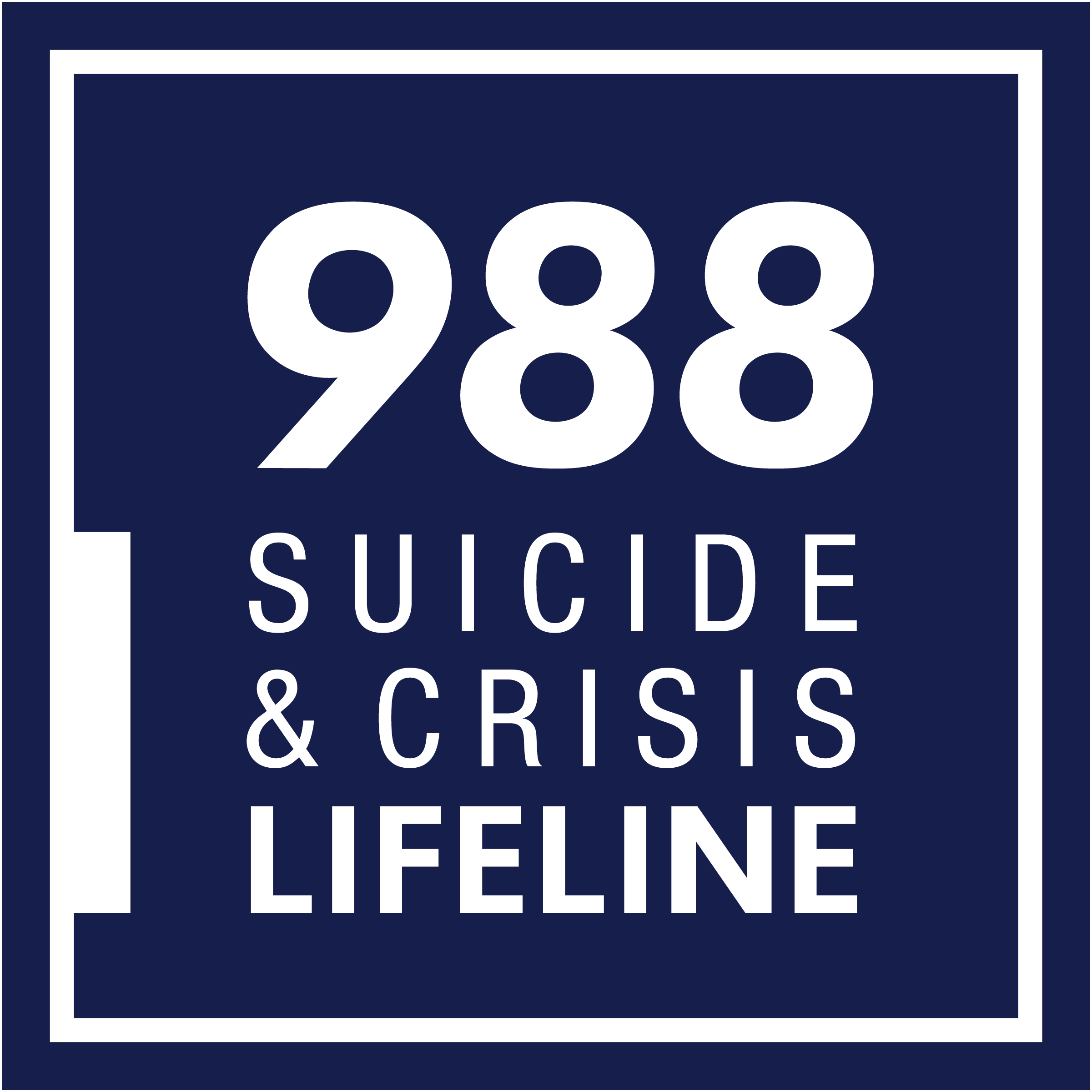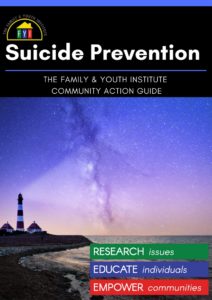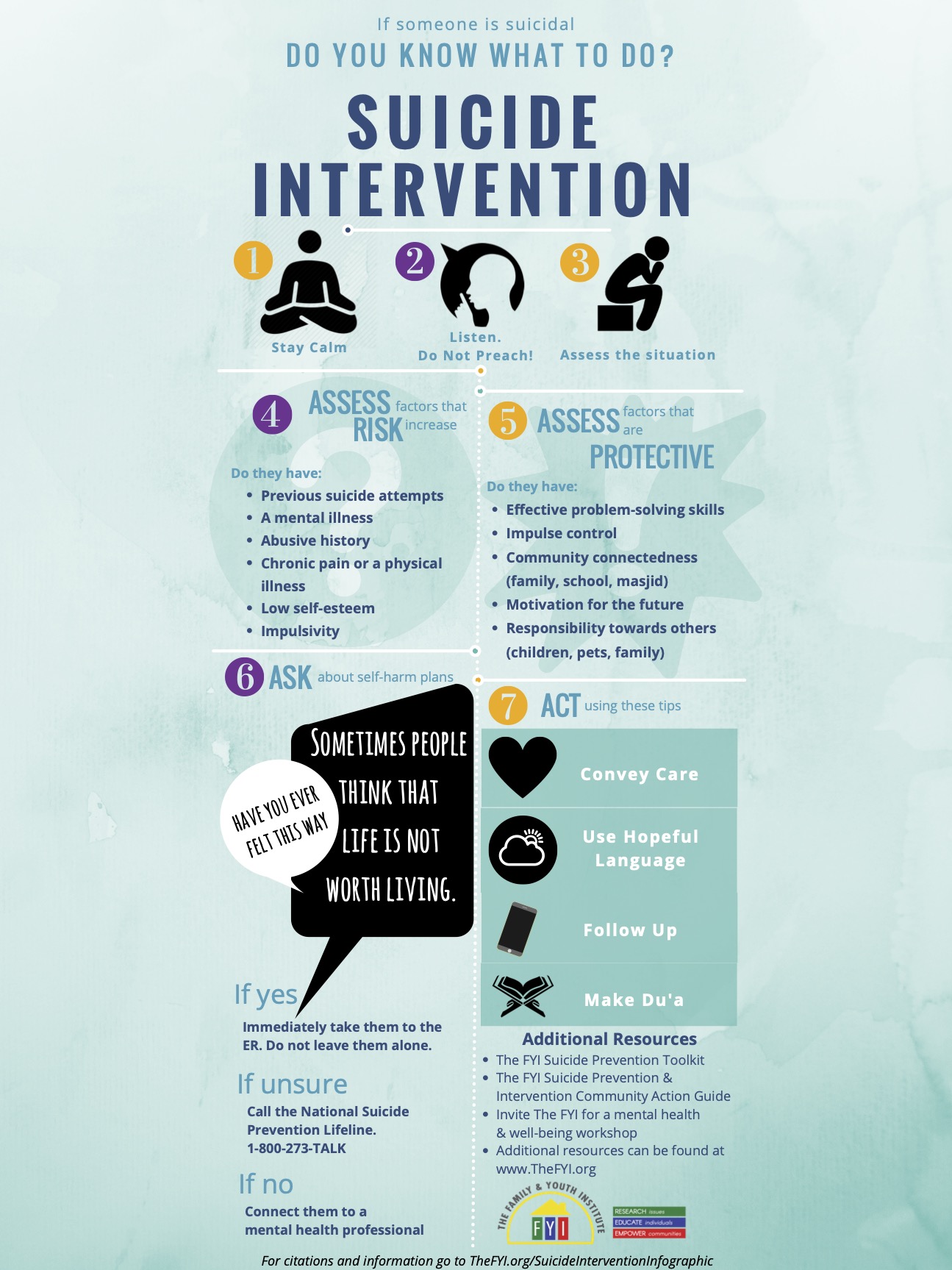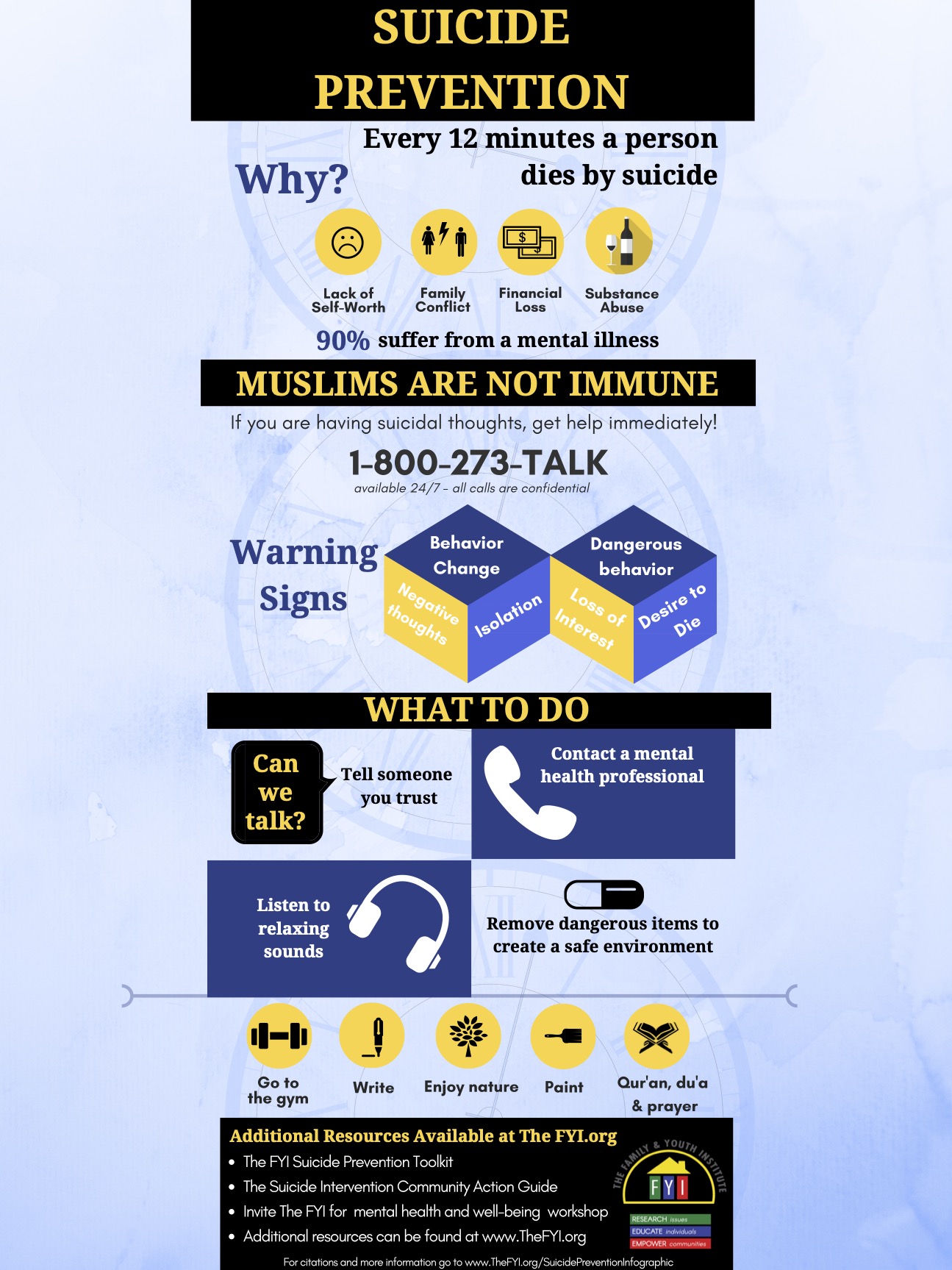The FYI’s Suicide Prevention Toolkit
What's on This Page
- Infographics: Suicide Prevention and Intervention
- Suicide Prevention Khutba Guide
- Resources for Parents, Community Leaders, Educators and Mental Health Professionals

Are You Having Suicidal Thoughts?
Call or Text 988, or Chat online at 988lifeline.org for free and confidential emotional support. They are available 24 hours a day, 7 days a week and also provide prevention and crisis resources for you or your loved ones, and best practices for professionals.
Creating a safety plan for yourself is important.
Here's how you can create one.
If you know that you sometimes get overtaken by thoughts of self-harm or suicide it is good to list out some of the supports that you do have in order to protect yourself. First, do you know what your warning signs are? Second, list out some of the coping strategies you might have used in the past. Third, who are people you trust that you might be able to call? This infographic has a continued list of how to best create a safety plan.
Has someone expressed suicidal thoughts to you?
Here's how you can help.
If someone you know is suicidal or has expressed suicidal thoughts to you, please use the resources below to understand your next steps and how to get them the help they need.
- How to Deal with Suicidal Thoughts and Feelings and Overcome the Pain is a step-by step guide to help you manage situations when someone you know is having suicidal thoughts. The first thing to remember is to remain calm and resist the urge to begin preaching to them. The most important thing you can do is listen and begin to assess the situation.
- Here is a short excerpt from the resource. “A suicidal person may not ask for help, but that doesn’t mean that help isn’t wanted. People who take their lives don’t want to die—they just want to stop hurting. Suicide prevention starts with recognizing the warning signs and taking them seriously. If you think a friend or family member is considering suicide, you might be afraid to bring up the subject. But talking openly about suicidal thoughts and feelings can save a life.”
Here Are Additional Resources on Navigating and Understanding Suicidal Thoughts:
- Suicidal thoughts don’t have to be common or frequent. Try these steps to manage those intrusive thoughts before they intensify, and to reduce their frequency
- Depression can lead to suicidal thoughts and ideations. There is always hope. This resource provides steps you can follow to help you cope with your feelings.
- Feeling hopeless is something that can intensify and lead to depression, and ultimately, suicidal intents, thoughts, or behaviors. This resource provides tips on how to reverse your hopelessness so it does not intensify in the long run.
- “Talking about suicide will encourage suicide attempts”. False! Myths like these prevent people from having healthy conversations about suicide and receiving support. Refer to this resource for more myths about suicides and how to debunk each myth.
- Identify the Risks and Warning Signs. “Suicide does not lend itself easily to an identifiable period of symptoms that occur before the disease; however, research does show that suicidal youth tend to give evidence about their distress both verbally and through changing behavior. Being able to recognize these clues and knowing the risk factors associated with adolescent suicide may help [you] prevent a [person] at-risk for suicide from attempting and/or dying by suicide.” Click here to continue reading.
Here is a short 4-minute video that will guide you through helping a friend/family member who has expressed thoughts of suicide.
Here is a short video (4 minutes) that describes common warning signs. This video provides encouragement for communicating directly and immediately, offers suggestions for what to say to a teen, and identifies ways to keep them safe.
Helping Different Demographics:
- Men die by suicide more than anyone else and are at greater risk for suicide attempts because they are socialized not to talk about their emotions or to get help. Check out this toolkit for information on suicide specifically for men: warning signs, risk factors, how to help, and so on.
- The elderly (especially older men) are also at a high risk for attempting and completing suicide. Learn about the risk and protective factors for this unique population.
- Different ethnic and racial populations have unique risk and protective factors for suicide. Refer to these fact sheets for more information on various groups.
- Check out this list of national resources for suicide prevention for individuals in minority communities.
Be Prepared for the Emergency Room
- You may need to take your friend/family member to the emergency room if they are currently feeling suicidal or are talking to you about killing themselves. This personal account might help you feel better prepared for what might be a confusing and scary experience.
- “When someone is actively suicidal, we often tell them to call the National Suicide Prevention Lifeline, call 911, or go to the local Emergency Room. These are all correct responses, but they are also scary, big steps for someone in a mental health crisis to take. This blog entry tries to demystify what happens at the emergency room when you go there for suicidal thoughts.”Click here to read more.
Mental Illness and the Family
Is Hospitalization Necessary? “Of the 5.4 million people who sought mental health treatment in 1990, less than 7% required hospitalization. More than half of those who needed in patient-care had schizophrenia, one of the most severe forms of mental illness. If you or someone you know may have a mental illness, the chances are that you will not need hospitalization. But, if you do, the following information will help assure you of the best care possible.” Click here to read more from mentalhealthamerica.net.
Looking for a therapist?
The RuhCare Directory can help you find a verified Muslim therapist.
While you may not be trained as a mental health professional, this guide is meant to equip you with the knowledge and tools to better prevent, intervene, and address suicide in your community and help save lives. Use this guide to:
- Increase community awareness and education
- Identify ways to integrate prevention efforts into your community
- Highlight relevant resources for those in need
Responding to Suicide in the Muslim Community
If your child lost a friend to suicide, how would you support him/her as they grieve the death of their friend? As a community leader or educator, how do you support Muslim children and youth?
If someone you know is having suicidal thoughts, this resource can serve as a quick reference and reminder. Learn how to assess the risks, assess the protective factors, which questions to ask, and how to act.
This infographic provides information on suicide rates and prevention methods. It is a quick-reference resource that is suitable for high traffic areas of your masjid, community center, or youth center.
Thinking about therapy?
Don’t know how to find a therapist? Wondering if therapy will work? The FYI’s Therapy Guide can help.
The FYI's Suicide Prevention Khutba Guide
Use this guide to prepare a Khutbah sermon about the importance suicide awareness and what communities can do to prevent suicide.
Resources for Parents, Community Leaders,
Educators and Mental Health Professionals
Understanding Self-Harm
Are self-harm and suicide Related?
“Because self-harm (also known as self-injury or self-mutilation) can involve physical injury (such as in the case of self-injury cutting), it can seem like self-harm and suicide are directly related. It’s normal to think that cutting one’s wrist, in the case of self-harm, may be a suicidal gesture; indicating that the person wishes to cut their wrist to die. However, this is typically not the case. In fact, most people who practice self-injury don’t intend to kill themselves and may even see self-injury as a way of avoiding suicide.” Click here to read more from healthyplace.com
Discussing Self-Harm
Talking about self-harm and suicide doesn’t mean it will put ideas into young minds. Read this resource for more information about the benefits of having these conversations and how to do so safely. Many people engage in self-harm because they are trying to cope with psychological or emotional pain. Try this list of coping skills to replace self-harming behavior.
This Infographic provides an overview of common types of self-harm, associated mental health issues, and causes. Check out the statistics, the implications for mental health, common types of self-harm, and causes of self-harm. Understanding is the first step towards prevention, protection, and intervention. This video explores the recovery of an individual who engages in self-harm and how loved ones can best support them on their journey.
Resources for Survivors and Family of Survivors
A Guide for Family Members after a Suicide Attempt
“Suicidal thoughts and actions generate conflicting feelings in family members who love the person who wishes to take his or her own life. That is why this guide was developed for you. It will give you some important points on how to take care of yourself and your family member following a suicide attempt and it will provide resources to help you move forward.”
National Day of Prayer, Hope & Life It is also important to remember to keep those people whose lives have been touched by a suicide attempt or a suicide loss in your thoughts and prayers. FYI, Researcher, Dr. Sawssan Ahmed participated in 2017’s National Action Alliance for Suicide Prevention day of prayer. To learn more about the National Day of Prayer for Faith, Hope & Life, go to www.faith-hope-life.org
Resources for After a Suicide Loss
Many of us worry about saying the wrong thing when supporting someone after a suicide loss. This guide provides more information on what grieving people need and how to support them.
Coping when a loved one dies from suicide can be challenging. This resource provides tips for grieving adults and children that can help you cope with a suicide loss.
This resource provides tips for the Muslim Community about addressing a suicide in a healthy manner.
Grieving the loss of someone from suicide is different from any other kind of grief as you experience different waves of emotions (shock, confusion, guilt, and hopelessness. This resource provides ways to navigate those feelings and begin the healing process.
Handbook for Survivors of Suicide Loss. “This may be the most traumatic loss you face in your lifetime. Facing it may be difficult – but you can and will survive this. You are now a “survivor,” or what is called a “survivor of suicide loss” and you are not alone. You may have many questions – Why has this happened? What will happen to my loved one after death? Was my loved one suffering when they died? Was the suicide my fault?” This handbook covers grief, how to tell others (children, friends, etc.), managing social media, financial concerns, and other resources.
A Handbook for Survivors of Suicide is a book for people who have lost a loved one to suicide, written by someone who has suffered the same loss. It addresses the emotional roller coaster a loss survivor experiences, grief, suicide facts and myths, battling guilt, moving on, and support.
Suicide Survivor Resource list. For more resources for the family members, friends, and loved ones of someone who has committed suicide, please see the Suicide Survivor Resource list. This sheet lists a selection of organizations, websites, and materials that can help people who have lost someone to suicide. Many of these resources were developed by survivors of suicide loss.
Read this article about how to support your children the community after a suicide loss in a Muslim community
Resource for Parents
There is much taboo about talking about suicide amongst our communities which prevent people from having healthy conversations about suicide and receiving support. Refer to this resource about the common myths surrounding suicides and how to debunk each myth.
When children become teenagers, it is hard for parents to know what their own teenagers are doing, thinking, or feeling. Teenage suicidal thoughts, intents, or ideation, unfortunately, go undetected. This resource provides ten ways parents can help prevent such tragedy.
Suicide is preventable. This resource provides risk factors and warning signs of suicidal intent, thoughts, and ideations among youth. It also provides tips about how to recognize these signs and ways you can prevent a tragedy.
Open communication with your teenagers is one of the best ways to protect them from suicide. This resource provides tips for parents on how they can improve their communication with their teenagers.
As a parent, coping with the loss of your child to suicide is one the hardest forms of grieving, which can prolong the mourning process. Learn from this parent’s struggles to work on your path to healing.
Resources for Community Organizers and Religious Leaders
The FYI Suicide Prevention Community Action Guide. The Family and Youth Institute Suicide Prevention Community Action Guide is designed to increase community awareness and education, help identify ways to integrate prevention efforts into your community, and highlight relevant resources for those in need. While you may not be trained as a mental health professional, this guide is meant to equip you with the knowledge and tools to better prevent, intervene, and address suicide in your community and help save lives.
The FYI has compiled a bullet-pointed khutba guide for imāms and khatībs as a way to support you through the conversation. This khutba guide was derived from sermons given by Sh. Yaser Birjas and Sh. Omar Suleiman and has been vetted by mental health professionals on The FYI Team. This is a critical topic that needs to be addressed and we hope you will be able to use it in your upcoming khutba (and/or share with other khateebs).
How to Create a Safety Plan. This website is designed by a social worker to help others create safety plans that are more user-friendly and updatable. Through her work, she found that the templates she had been using didn’t cover everything she’d like, so she created a new safety plan template.
Video Series for Faith Community Leaders. This video series from the Interfaith Network on Mental Illness is a discussion around suicide prevention, warning signs, responding to a suicidal person, helping family members after a suicide attempt, and building congregational interventions.
The Role of Faith Community leaders is a resource that outlines information needed by faith community leaders on assessing suicide risk, preventing suicide in the congregation, and addressing suicide within the congregation.
Mental Health Guide for Faith Leaders. This Quick Reference Guide for Mental Health for Faith Leaders guides faith leaders by highlighting observable signs of mental illness, guides on how to respond, and make appropriate referrals.
Recommendations for Religious Services after a Suicide. This resource, After a suicide: Recommendations for Religious Services & Other Public Memorial Observances is a guide for faith leaders as they care for those who have survived the loss of a loved one due to suicide. This document provides background information, suggests ways to care for and support survivors, offers recommendations for planning memorial services, and lists additional resources.
After a Suicide: A Toolkit for Schools identifies ways to deal with a tragic loss in a community. The content will help you build an effective and coordinated crisis response, help individuals cope with their feelings, work with the community, address social media, and minimize the risk of suicide contagion. Though it is written for educators and school leaders, the content can be easily transferable for communities and an excellent resource for community leaders.
Resources for Educators
There is much taboo in talking about suicide amongst our communities which prevent people from having healthy conversations about suicide and receiving support. Refer to this resource about the common myths surrounding suicides and how to debunk each myth.
Suicide is preventable. This resource provides risk factors and warning signs of suicidal intent, thoughts, and ideations among youth. It also provides tips about how to recognize these signs and ways you can prevent a tragedy.
After a Suicide: A Toolkit for Schools identifies ways to deal with a tragic loss in a school community. The content seeks to help promote an effective and coordinated crisis response, help individuals cope with their feelings, guide educators in working with the community, addressing social media, and minimize the risk of suicide contagion.
Model School District Policy on Suicide Prevention provides guidelines for schools on suicide prevention. Topics covered include policy implementation, staff professional development, youth programming; In school assessment and referral; suicide attempts (both inside and outside school), parent involvement, district liability, communication guidelines.
Resources for Mental Health Professionals
There is much taboo about talking about suicide amongst our communities. Many myths prevent people from having healthy conversations about suicide and receiving support. Refer to this resource about the common myths surrounding suicides and how to debunk each myth.
This article gives a look at how psychologists in a variety of settings are building on one another’s work to address today’s most challenging issues. Here is how they are working together to advance the field of suicide prevention.
Gifts from Within: PTSD resources for survivors and caregivers summarizes understanding, assessing, and treating survivor’s guilt for clinicians.
Facilitating a Suicide Survivors Support Group provides detailed directions on planning, organizing, facilitating a suicide survivors’ support group. Additional professional resources can be found here.
Counseling Muslims: Handbook of Mental Health Issues and Interventions is a resource for mental health practitioners that was designed using community-based and clinical experience and research. The book discusses topics that have been ignored in the previous literature about Muslims, such as sex therapy, substance abuse counseling, university counseling, and community-based prevention. Chapters integrate tables, lists, and suggested phrasing for practitioners, along with case studies that are used by the authors to help illustrate concepts and potential interventions.
Additional Resources and Helplines
The Naseeha Muslim Youth Helpline provides a free and confidential peer-to-peer service to the Muslim youth by providing realistic and attainable solutions according to Islamic teachings.
Amala Hopeline is a hotline that seeks to offer an accessible form of culturally competent counseling and serves as a resource for Muslim youth. They are open to taking calls: Monday, Wednesday, Friday, Saturday, Sunday from 6pm-10pm PST.
Stones to Bridges is a platform where Muslim youth in North America can freely and comfortably express and address their struggles and concerns. Stones to Bridges aims to promote the youth’s emotional, social, and mental well-being by addressing their needs through a variety of avenues.
This toolkit was authored by Mariam Kandil, MA; with help and support from Sameera Ahmed, Ph.D.; Saara Patel, MSW; Saba Maroof, MD; and Sarrah AbuLughod, MA.
An update to this toolkit was generously funded by the

Feedback
Your feedback is incredibly valuable to us. It helps us refine and improve our efforts to better serve you. Whether it’s positive comments that motivate us or constructive criticism that guides our enhancements, your insights are an essential part of our journey. We genuinely appreciate your time and input as we work to provide the best possible experience. Thank you for being a part of our process!



